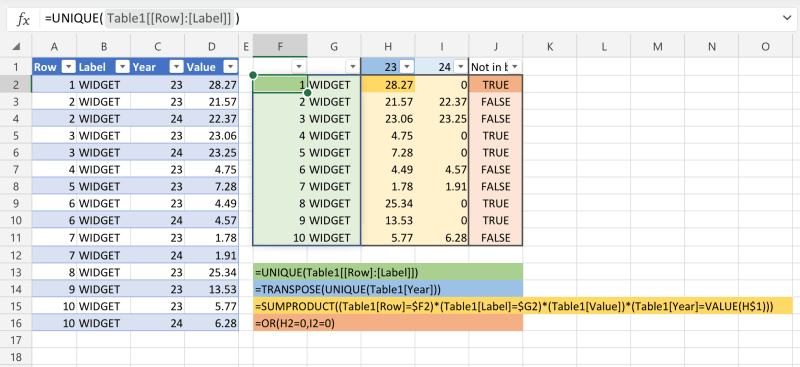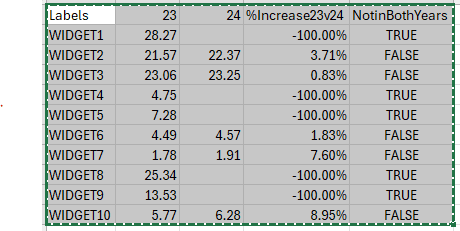I have created a power pivot table to show the % year on year (23 to 24) change, of the weighted average prices per part
Not all parts had sales in both 23 and 24 = TRUE in the last column
I would like to filter out the TRUE's or even create a slicer on that column
When I dragged the column "NotinBothYears" to the filter box in but got the error message
"The field you are moving cannot be placed in that area of the report"
Apart from the Part column ,all columns are measures
The pivot table looks like this
Row Labels 23 24 %Increase23v24 NotinBothYears
1WIDGET 28.27 -100.00% TRUE
2WIDGET 21.57 22.37 3.71% FALSE
3WIDGET 23.06 23.25 0.83% FALSE
4WIDGET 4.75 -100.00% TRUE
5WIDGET 7.28 -100.00% TRUE
6WIDGET 4.49 4.57 1.83% FALSE
7WIDGET 1.78 1.91 7.60% FALSE
8WIDGET 25.34 -100.00% TRUE
9WIDGET 13.53 -100.00% TRUE
10WIDGET 5.77 6.28 8.95% FALSE
Not all parts had sales in both 23 and 24 = TRUE in the last column
I would like to filter out the TRUE's or even create a slicer on that column
When I dragged the column "NotinBothYears" to the filter box in but got the error message
"The field you are moving cannot be placed in that area of the report"
Apart from the Part column ,all columns are measures
The pivot table looks like this
Row Labels 23 24 %Increase23v24 NotinBothYears
1WIDGET 28.27 -100.00% TRUE
2WIDGET 21.57 22.37 3.71% FALSE
3WIDGET 23.06 23.25 0.83% FALSE
4WIDGET 4.75 -100.00% TRUE
5WIDGET 7.28 -100.00% TRUE
6WIDGET 4.49 4.57 1.83% FALSE
7WIDGET 1.78 1.91 7.60% FALSE
8WIDGET 25.34 -100.00% TRUE
9WIDGET 13.53 -100.00% TRUE
10WIDGET 5.77 6.28 8.95% FALSE


![[glasses] [glasses] [glasses]](/data/assets/smilies/glasses.gif) Just traded in my OLD subtlety...
Just traded in my OLD subtlety...![[tongue] [tongue] [tongue]](/data/assets/smilies/tongue.gif)

